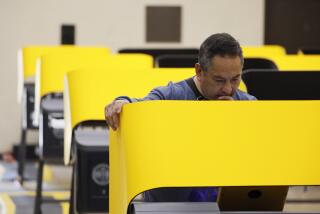Op-Ed: Poll worker shortages are threatening the 2020 election. Young people can be the solution

In the 2018 midterm elections, about six out of 10 U.S. poll workers were over the age of 60, and more than 80% were over 40. That presents a major problem for the 2020 presidential contest.
The age group from which most poll workers are drawn is particularly at risk for COVID-19, and primaries held after the global pandemic made clear that finding enough poll workers to staff the November election is likely to be difficult. In Wisconsin’s April primary, for instance, a lack of available poll workers caused the city of Milwaukee to drastically pare down the number of polling locations, from its typical 180 to a mere five.
Luckily, this is a problem with a relatively simple solution: Young people should step up and be poll workers. It’s what I did for the Texas primary in March. It was relatively easy, I was paid for my work, and it was wildly rewarding to help hundreds of people vote, many of them college students voting for the first time.
In the days leading up to the March election, I heard rumblings about a severe shortage of poll workers in Travis County due to fears of COVID-19. One of the few polling locations that serves the University of Texas at Austin’s student community was struggling to find a full contingent of poll workers to staff it. As a former student, I knew that polling locations near the university already face hours-long lines of voters. If we couldn’t staff this polling location for the primaries, it might shut down by November, making it even harder for students to vote. So I volunteered to pitch in as a poll worker, struggling out of bed at 5 a.m. on election day to help my community cast ballots until 10 p.m. that night.
Of course, not all young people are able to serve as poll workers. Election day is always on a Tuesday, when many of us have work or school. The pandemic has exacerbated challenges around financial stability, physical and mental health and family responsibilities for young people, as for everyone else. But for those who have the time and ability to volunteer, the process is relatively easy and has few requirements. In addition, almost all poll workers are compensated for their work, although the amount depends on your state and local jurisdiction.
While the process to become a poll worker varies by state, workelections.com offers a one-stop location for information about staffing your local polling place. Initiatives such as Power the Polls, which hopes to recruit 250,000 Americans to serve as poll workers this year, also help guide people through the process.
The number of polling locations across the country has been rapidly falling in recent years even before the coronavirus, and many fear that the closures have disproportionately harmed impoverished areas and communities of color. During the 2018 midterms, Latinx and Black voters were more likely to report longer wait times at polling locations than white voters.
It should be no surprise that polling location closures often worsen wait times, making voting less accessible to certain communities. In the wake of the Supreme Court’s 2013 decision in Shelby County vs. Holder, which diluted the Voting Rights Act, the Leadership Conference Education Fund found that at least 1,688 polling locations were shut down in areas where closures would have previously required approval under the Voting Rights Act. Texas alone closed 750 polling locations during that period, the largest number of them in Dallas County, which has a majority Latinx and Black population. Travis County, where I worked as a poll worker last March, had the second largest number of closures, in a county that is over 30% Latinx.
Fully staffed polling places aren’t a panacea to the much larger issue of voter suppression and the availability of places to vote. But over the last four years, as I’ve fought to place polling locations on college campuses across the country, a common pushback I’ve heard from election officials is that they don’t have the capacity to staff additional polling locations. Having adequate numbers of poll workers is a crucial prerequisite to advocating for additional polling locations and a powerful way to fight back against the potential closure of locations in marginalized communities.
As the number of potential poll workers continues to dwindle, we shouldn’t just be concerned about the polling locations that we will lose — we also should be advocating for more locations in communities that have been historically discriminated against. Without poll workers, that becomes difficult if not impossible.
While the need for younger poll workers is greater during a pandemic, it is also a need that will exist long-term. After all, representation matters. Poll workers are the gatekeepers standing between a person and the ballot box. When we have poll workers who are representative of the community they serve, they are more likely to understand the unique situations and barriers that voters from that community face.
Those of us who have the privilege of time and are at a lower risk of contracting COVID-19 can ensure that polling locations stay open in at-risk communities by working the polls this November. As young people, we have power to influence the future, both at the ballot box and outside of it. Part of that means taking control and harnessing that power, as we’ve seen young people do time and time again.
Maya Patel is a voting rights activist and the Texas state coordinator at Campus Vote Project. Twitter: @maya_m_patel.
More to Read
A cure for the common opinion
Get thought-provoking perspectives with our weekly newsletter.
You may occasionally receive promotional content from the Los Angeles Times.






